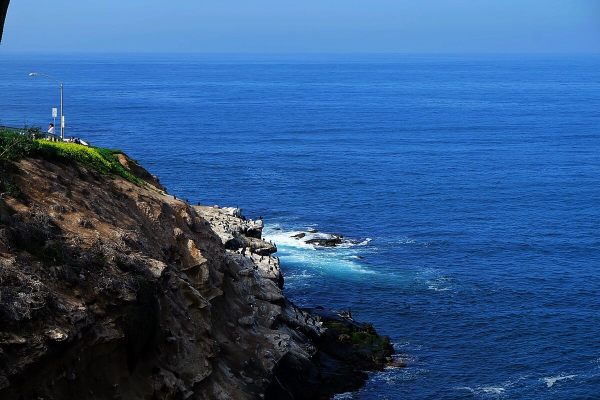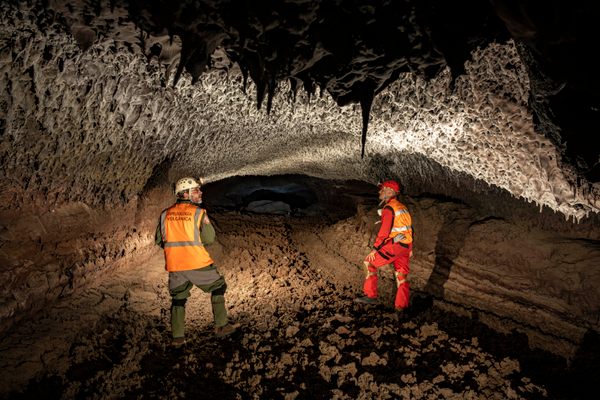The Rapture of the Deep: Descending into Germany’s Harrowing Underground Realm
Entering Riesending: from this point it is 600 feet straight down (photo by Markus Leitner/Bavarian Red Cross, via Wikimedia)
This unassuming hole in the ground is the only known access point to Germany’s deepest cave — the Riesending-Schachthöhle. It recently made headlines around the world when a man named Johann Westhauser was seriously injured in a rockslide 3,200 feet underground. It took 12 days to bring him back to the surface, in a rescue operation that grew to include over 700 people.
Stretcher & a section of rigging used to pull Westhauser through the Riesending (photo by Markus Leitner/Bavarian Red Cross, via Wikimedia)
Westhauser was no amateur who got in over his head. He’s an experienced caver, and probably knows the Riesending as well as anyone else on Earth. He was a member of the team that first began exploring and mapping the system in 1995. But the Riesending is not an ordinary cave. Its name translates to “massive thing,” a fitting descriptor for this gigantic underground realm. There are almost 12 miles of passages, sheer vertical shafts hundreds of meters high, and an underground lake lying between the surface and the cave’s deepest point over 3,700 feet below.
Profile of the Riesending Cave; scale in meters. Westhauser was injured between bivouacs 5 and 6. (map by Maxxl²/ARGE Bad Canstatt, via Wikimedia)
The Riesending was formed by acid-charged rain and groundwater seeping through openings in the limestone near the peak of the Untersberg massif — a 6,400-foot table-top mountain that towers over the landscape between Germany and Austria. Over time, the porous limestone dissolved away, leaving behind caverns and shafts in much the same way that a river carves a canyon. Because it begins on the top of such a large mountain, the water that formed Riesending had a long way to travel before coming to rest at the water table — making it much deeper than other, similar cave systems.
The Untersberg Massif, viewed from Germany (photo by Malouette/Flickr user)
Legend holds that 12th century Holy Roman Emperor Frederick I is asleep deep inside Untersberg mountain, poised to wake and restore Germany to its ancient greatness as soon as his beard grows around the table three times and/or “the ravens cease flying.” So everyone has to be extra quiet inside.
Frederick I dispatches a boy from his lair to see if the ravens are still flying (via Wikimedia Commons)
The Riesending is called a “pit cave” because of its vertical orientation; this is what makes it so technically challenging to traverse. Because the access shaft and much of the interior structure run straight up and down, cavers must descend and ascend on ropes for large parts of the cave’s length.
Pit cavers get down these deep shafts the same way climbers descend cliffs; they anchor ropes and rappel down to the bottom. The hard part is getting back up. Using traditional rock climbing techniques is often infeasible or just impossible in a deep pit cave like the Riestenberg. Instead, cavers use a special piece of equipment called an ascender to inch back up the same rope they used to rappel down — a technique sometimes called “jumaring” or “jugging.”
Caver rappelling into a 96-foot pit cave in West Virginia, about 1/6 the depth of the Riesending’s entrance shaft (photo by Dave Riggs/Flickr user)
Dr. George Veni directs the National Cave and Karst Research Institute in Santa Fe, New Mexico. Although he hasn’t been into the Riesending, he’s been exploring and studying caves like it for over 20 years. Navigating through such an environment, he says, is a physical, technical, and even mental challenge: “Cavers who explore caves like Riesending usually spend weeks getting into shape in order to maximize what they’ll be able to do, with the greatest safety and ease.”
Reaching the bottom of a cave that deep, he explains, is never accomplished “on a single trip by a single team. Many hundreds of pounds of rope and associated hardware, not counting personal food, water, lights, batteries, first aid kit, etc., are needed so these caves are explored and rigged in stages over several trips.” The team that set the world record for depth in Krubera Cave in 2012 followed in the footsteps of many previous expeditions, but were still underground for 27 days in total.
If you’re headed to the bottom of the Riesending, you’ll need to bring a boat as well. About 930 meters below the entrance point, there is a vivid blue lake that must be crossed by raft in order to proceed deeper into the cave. With temperatures constantly hovering just above freezing, and humidity near 100%, swimming is not an option.
In addition to the physical demands and technical skill required to navigate these environments, Dr. Veni says there is a strong psychological component to exploring exceptionally deep caves: “Far more than with distances in horizontal caves, deep caves produce a more profound feeling of remoteness. Sometimes very fit people, but not very experienced with caves, do not go as deep as they physically could because of the psychological discomfort with their distance from the surface. As a take-off on diver terminology, we call this discomfort ‘The Rapture of the Deep’.”
There must have been something alluring about this feeling of remoteness for Johann Westhauser, but his near fatal accident is a reminder of how dangerous such an alien environment can be.
Descend into more of the world’s strange and beautiful underground realms on the Atlas Obscura >

















Follow us on Twitter to get the latest on the world's hidden wonders.
Like us on Facebook to get the latest on the world's hidden wonders.
Follow us on Twitter Like us on Facebook